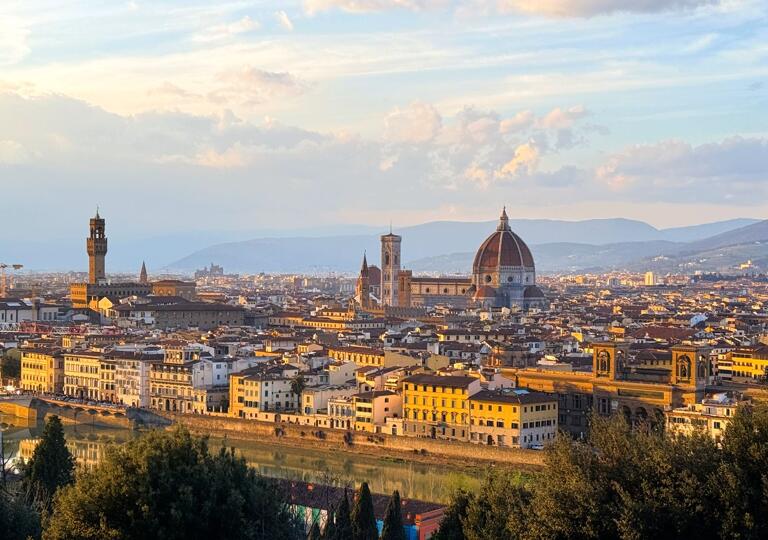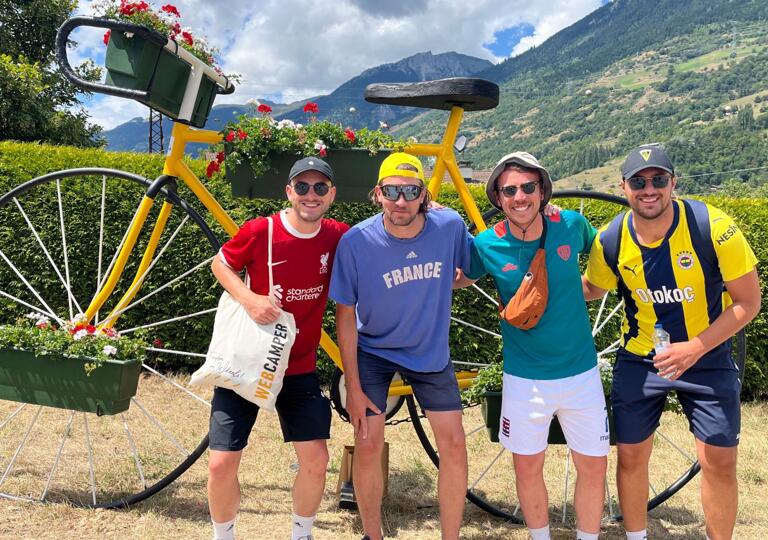DAY 1
Departure from Luxembourg, arriving late in Florence
The navigator had estimated our journey would take approximately 9 hours and 18 minutes; however, in reality, we spent about 13 hours on the road, including breaks, while maintaining an average speed of 110 km/h.
Despite it being a lengthy drive and our first time traveling in a motorhome, we felt extremely safe and comfortable throughout.
DAY 2
Exploring Florence
On our first day in beautiful Tuscany, we started slowly, enjoying a nice breakfast, getting to know our motorhome better, and checking out what the campsite had to offer. Later in the day, we took the campsite’s shuttle to get to the centre of Florence, because no trip to Tuscany is complete without visiting its famous capital. Florence is a breathtaking city, filled with amazing buildings, churches, and art galleries at every turn, offering endless sights like the Uffizi, the Duomo, and the Ponte Vecchio bridge, not to mention the chance to shop at stores of famous designers who started here back in the 1920s and local craftspeople who make everything from gold jewellery to shoes.
DAY 3
More of Florence and then off to Siena
After checking out, we left our camper in the parking lot at the campsite, eager to dive back into the wonders of Florence for a second day. There's a richness to this city that truly requires at least two days to begin to appreciate fully. This way, you can take your time, try out different places to eat, and really live in the moment.
Later that day, we made our way to Siena, driving for about an hour and a half. We found a cosy campsite in Monti, not too far from Siena, about half an hour away. Even though we got there after the reception had closed for the day, we didn't run into any trouble finding a spot for our camper and getting it connected to the power supply.
DAY 4
Discovering Siena and the Val d'Orcia countryside
First stop: Siena
Our morning in Monti began peacefully as we enjoyed breakfast and tended to the camper's needs - emptying the grey water, refilling with fresh water, and clearing out the toilet. After these tasks were completed, we checked out of the Monti campsite and headed towards Siena. We found a parking lot 1.5 kilometers from Siena's center, predominantly used for buses but also offering a few spaces for motorhomes. Normally, a walk from this lot to the city center would take around 30 minutes. However, electric escalators located just a 10-minute walk from where we parked significantly shortened our journey, taking us directly up to the city and reducing our walk to merely 15 minutes.
Second stop: Val d'Orcia
On our way to Pienza, we stopped multiple times in the picturesque Val d'Orcia region, which is roughly an hour's drive from Siena and merely 20 minutes away from Pienza. After witnessing what could easily be described as the most stunning sunset in all of Tuscany, we continued our journey to Pienza, where we spent two nights.
When I think of Tuscany, the immediate image that springs to mind is a boundless stretch of golden hills dotted with lines of cypress trees. The beauty of Val d'Orcia is something I find myself struggling to fully capture in words, and I deeply regret not spending more time there. I would earnestly recommend dedicating at least two days to exploring this area. The valley is dotted with picturesque medieval villages like Pienza, San Quirico d’Orcia, and Monticchiello. This region is also celebrated for producing the renowned Brunello di Montalcino wine, near the majestic Sant’Antimo Abbey. Moreover, the area has thermal baths that have been used since Roman times, with the romantic town of Bagno Vignoni featuring a large thermal bath right in its central square.
Here are the most picturesque places to take pictures in Val d'Orcia:
- Agriturismo Baccoleno
It is famed for its winding entrance road, offering a captivating introduction to the estate. The best views of this road are enjoyed from the nearby hills, where parking is conveniently available close to the north entrance. Remember, drone flying is restricted here since it's private land. If you're considering a stay in Val d’Orcia, Baccoleno offers excellent accommodation.
- Agriturismo Poggio Covili
This spot is well-known for its frequent appearance on postcards, drawing photographers to the long line of cypress trees leading to its entrance. The best shots of Agriturismo Poggio Covili are taken from higher up, and luckily, you can easily park your car on the road nearby to get the perfect angle.
- Bosco di Cipressi
At first glance, this cypress forest at the top of a hill might not seem like much, but it's actually a favourite among photographers looking for that quintessential Tuscan shot.
- Cappella della Madonna di Vitaleta
This charming little chapel, framed by two cypress trees, is one of the most snapped churches in Tuscany.
- Via Crete Senesi
Near Asciano lies Crete Senesi, translating to the Clays of Siena, a picturesque landscape south of Siena characterized by its bare, grey soil and rounded hills, evoking images of desert dunes.
- The Elysian Fields
As depicted in the final scene of the movie Gladiator where Maximus Decimus Meridius, portrayed by Russell Crowe, walks through the wheat fields into the afterlife, was filmed in Val d’Orcia, just a few kilometers outside Pienza. This picturesque setting was chosen by Ridley Scott as the embodiment of the Roman's Paradise, making it a must-visit for fans and those curious about the real-life location of these iconic cinematic moments.
- Pienza
Known as the heart of Val d’Orcia, Pienza is a medieval town that caught the eye of filmmakers and was featured in The Gladiator. Famous for its Pecorino di Pienza cheese, the town is surrounded by breathtaking panoramic views of the Tuscan hills.
- Monticchiello
Close to Pienza, Monticchiello is a lesser-known medieval town perched on a hill, with stunning views over the valley. It's often referred to as the terrace of Val d’Orcia. Don't miss the Monticchiello Punto Panoramico and Cipressi di Monticchiello for some of the best vistas in the region.
- Biancane di Leonina
It is known as the Accona desert because it gets darker when wet and turns white under the sun's heat. Despite being called a desert, the area is dotted with bushes and small trees, making it a popular spot for hikers with several trails crisscrossing through it.









